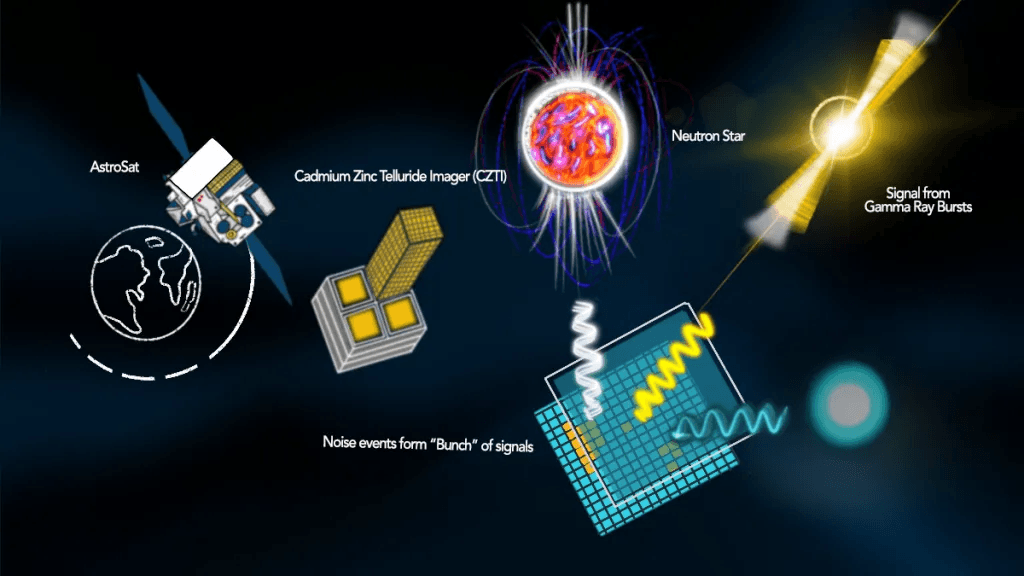
Unnati Ashar
Once a satellite is in orbit, astronomers wait with bated breath for its data — the very treasure for which instrumentalists toil for years together to construct payloads, put them on the satellite, and see it through its launch, safe in its orbit. However, the data obtained from any satellite is not immediately usable. Data analysts and software writers bring it into a usable form. They filter, screen, and process it such that they can extract useful scientific information from it. (See the previous piece in this series here.)
Take the case of CZTI. Whenever an X-ray photon strikes one of its pixels, the pixel registers it as an ‘event’. However, apart from the CZTI’s astronomical target source, other sources of X-rays, like cosmic rays, bombard the detector. But how will the detector determine whether a particular ‘event’ has occurred due to its target source or a stray cosmic ray? Here is where data analysts pitch in. They find differences between how photons obtained from a target source interact with the pixels and how those obtained from a background cosmic ray interact. Thus, they filter true ‘events’ from cosmic ray-induced events, hereafter called ‘noise events’, as they constitute non-useful data for CZTI.
The number of background events is much more than the number of source events for a hard X-ray instrument like CZTI. Prof. A. Raghu Rao, professor in the Department of Astronomy and Astrophysics at the Tata Institute of Fundamental Research, Mumbai, explains, “To give the feel for the numbers: the brightest hard X-ray source in the sky, Crab Nebula, gives about ten events per second. The observed background is ten times more.”
During the first few days of the mission itself, the scientists observed the presence of noise due to cosmic rays in CZTI data. They identified that when a cosmic ray hits the detector, it triggers three or more events within 20 microseconds, which they classify as a ‘bunch’. Events triggered by astronomical sources do not exhibit ‘bunching’ and are from astronomical sources of the scientists’ interest, which they call true events. The ground analysis software of AstroSat filters background events by identifying the bunches.
Scientists involved in the present study noted another better signature that could help improve the filtering process in the current pipeline. They observed that events generated due to noisy events like cosmic rays bunch together on the pixelated detector, a signature not observed when a target X-ray source generates it. They used this information to segregate cosmic ray-induced noise events from true events. They tested this technique on gamma-ray bursts (GRBs) and found it preserved true events while eliminating the noise.

While the technique works well for persistent astronomical sources, pixelated instruments like CZTI are adept at detecting ‘transient’ sources like GRBs, as we discussed before. Segregating background events from transient events is even more difficult because the ground analysis software discards an event as ‘noise’ if the count rate increases more than a threshold value. But GRBs have high brightness and are of very short duration — from a few seconds to a few minutes. Hence, the software classifies photons from GRBs as ‘noisy events’ instead of registering them as true events.
Thankfully for the CZTI scientists, CZTI possesses a quality that helps them segregate background events even from transient events. CZTI, while recording any event, stores information such as its energy, location, and time of arrival. The astronomers discovered that that is a treasure mine of information. How events cluster together in time and over the detector plane and how events from noise differ in energy levels from true events together tell a story. They used the information to understand and segregate events triggered by astronomical photons from events triggered by cosmic ray photons and other detector-induced noise. The astronomers tested their new data processing algorithm on 11 GRBs detected by CZTI. They demonstrated that it could successfully segregate noise events from true events for persistent as well as transient sources.
Sifting true events from noise is as crucial as getting data, and scientists did a good job doing that here! But the CZTI can do more. Another powerful beast it can morph into is that of an ‘all-sky monitor’. It can see target astronomical sources not only within its field-of-view, but also beyond it — a feature mentioned before, but something that will be discussed in detail in the next and last part of this series!
This article is based on the research findings from the papers
Characterisation of cosmic ray-induced noise events in AstroSat-CZT imager
A generalized event selection algorithm for AstroSat CZT imager data





